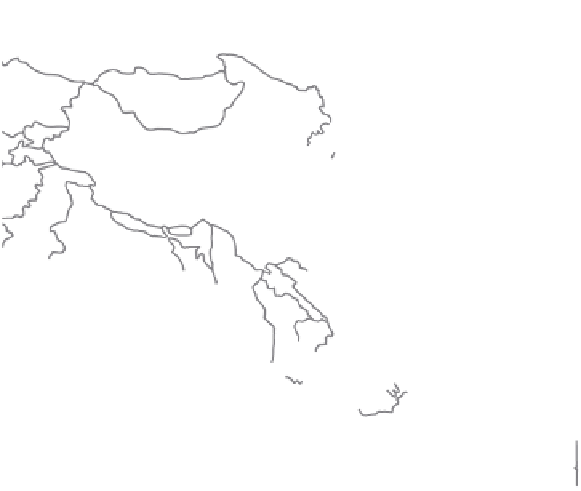Geography Reference
In-Depth Information
Religion and Belief Systems
Bangladesh in 1971. Furthermore, place names are
frequently changed. T Tokyo was once known as Edo.
Others are newer, as with the restoration of tradi-
tional names. Bombay is now called Mumbai. Be
forewarned: If you send a letter to “Bombay ,” it will
likely be returned to you marked “No such place.”
Rangoon, Burma, is currently Yangon, Myanmar.
However, in deference to the majority of Burmese
who reject their country' s military regime and still
use the names “Rangoon” and “Burma,” we will use
Yangon (Rangoon) and Myanmar (Burma) in this
textbook.
When speaking of a place in a historical con-
text, we will spell it as it was referred to at that time,
followed by the current spelling in parentheses—for
example, “In old Siam (Thailand). . . .” In modern
context, current names will stand alone—for exam-
ple, “Chennai” instead of Madras. This might seem
confusing, but, as you will find out, different maps
and atlases employ different spellings. More impor-
tantly , residents of places frequently continue to use
the name that has been in use the longest, or the
one that they have a preference for. For example,
in the 1990s, Calcutta was renamed Kolkata, but
many people continue to use the name Calcutta.
Although Saigon was renamed Ho Chi Minh City
by the communists after the Vietnam War, most
people still call it Saigon.
Now let us turn to an aspect of culture of paramount sig-
nificance:
religion
. Religion, or a set of sacred beliefs,
pervades everyone' s life, whether consciously or uncon-
sciously . Aside from being evident in the cultural land-
scape in the form of sacred structures and other
phenomena, religion functions in a variety of ways in so-
ciety . Religions define male and female roles; affect polit-
ical systems and policies; influence agricultural and
dietary practices; shape environmental values; impact
economic development; and, frequently , are used by
politicians to create dissension and strife.
Hinduism, Buddhism, and Islam are the major reli-
gions in Asia, but Christianity and other belief systems
such as Sikhism, Confucianism, Daoism, and animism
are important in specific regional settings. At this junc-
ture, I will discuss the origin,
diffusion
or spread, and
key tenets of four religions in Asia: Hinduism, Bud-
dhism, Christianity , and Islam. Others will be discussed
in their regional contexts in subsequent chapters.
All four religions have their
hearth areas,
or places of
origin, in continental Asia. Each of these diffused by one
or more means: conquest, word of mouth (contact diffu-
sion), migration of believers (relocation diffusion), and
the work of missionaries (proselytization). Merchants
and traders played significant roles in spreading religion,
especially in the case of Buddhism and Islam (see Fig-
ures 1-5 and 1-6).
Figure 1-5
Distribution of major religions in East,
South, and Southeast Asia.
James
M. Rubenstein,
Human Geography
,
9th edition, 2008 pp. 184-5. Upper
Saddle River, NJ: Pearson Prentice-Hall.
2%
Sunni Muslim
10%
Buddhist
5%
Shinto
1%
Other
religions
EAST
ASIA
64%
Non-
religious
18%
Chinese
folk
40
°
PACIFIC
OCEAN
5% other
religions
30
°
22%
Catholic
4%
Nonreligious
5%
Protestant
13%
Buddhist
20
°
BAY OF
BENGAL
51%
Sunni
Muslim
ARABIAN
SEA
2%
Sikh
4%
Other
religions
2%
Christian
3%
Shiite Muslim
SOUTHEAST
ASIA
10
°
24%
Sunni
Muslim
Equator
140
°
0
°
65%
Hindu
SOUTH ASIA
INDIAN OCEAN



























































































































































Search WWH ::

Custom Search